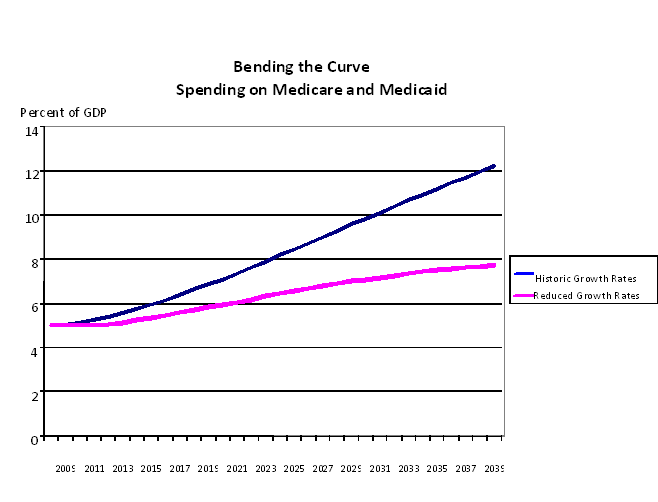Medicare Trustees to America: Bend the Curve!
Posted by on May 12, 2009 at 05:09 PM EDT
Today, the Trustees of the Medicare and Social Security Trust Funds released their annual reports detailing the financial operations and long-term positions of the Medicare and Social Security Trust Funds. It should come as no surprise that the Trustees’ Reports continue to show long-term financing challenges in both programs, and that those facing Medicare are much greater and more imminent than those of the combined Social Security Trust Funds. Why is this happening? The retirement of the Baby Boom? Mostly not – it’s largely due to the growing costs of covering each Medicare beneficiary, rather than to the growing number of beneficiaries in the Medicare program.
That’s why I’ve said on numerous occasions – and the President said yesterday in his remarks – that reducing the growth rate of health care costs is the single most important fiscal issue we face as a country—and why doing so will relieve the pressure on the wages and pocketbooks of American families. This is also why the President met Monday with a wide array of leaders from many different sectors of the health industry who pledged to take aggressive steps to cut the growth rate of national health care spending by 1.5 percentage points each year on average over the next 10 years—a pledge that would save our country more than $2 trillion through lowered costs for consumers, businesses, and government. According to rough preliminary estimates, slowing health care cost growth by 1.5 percentage points per year could add four years of solvency to the Medicare Trust Funds. To fully understand how this small reduction in health care cost growth can help secure Medicare and Medicaid, look at the graph below.
This graph, and the report issued today, should reinforce all our efforts to get health reform done this year.

That’s why I’ve said on numerous occasions – and the President said yesterday in his remarks – that reducing the growth rate of health care costs is the single most important fiscal issue we face as a country—and why doing so will relieve the pressure on the wages and pocketbooks of American families. This is also why the President met Monday with a wide array of leaders from many different sectors of the health industry who pledged to take aggressive steps to cut the growth rate of national health care spending by 1.5 percentage points each year on average over the next 10 years—a pledge that would save our country more than $2 trillion through lowered costs for consumers, businesses, and government. According to rough preliminary estimates, slowing health care cost growth by 1.5 percentage points per year could add four years of solvency to the Medicare Trust Funds. To fully understand how this small reduction in health care cost growth can help secure Medicare and Medicaid, look at the graph below.
This graph, and the report issued today, should reinforce all our efforts to get health reform done this year.

White House Blogs
- The White House Blog
- Middle Class Task Force
- Council of Economic Advisers
- Council on Environmental Quality
- Council on Women and Girls
- Office of Intergovernmental Affairs
- Office of Management and Budget
- Office of Public Engagement
- Office of Science & Tech Policy
- Office of Urban Affairs
- Open Government
- Faith and Neighborhood Partnerships
- Social Innovation and Civic Participation
- US Trade Representative
- Office National Drug Control Policy
categories
- AIDS Policy
- Alaska
- Blueprint for an America Built to Last
- Budget
- Civil Rights
- Defense
- Disabilities
- Economy
- Education
- Energy and Environment
- Equal Pay
- Ethics
- Faith Based
- Fiscal Responsibility
- Foreign Policy
- Grab Bag
- Health Care
- Homeland Security
- Immigration
- Innovation Fellows
- Inside the White House
- Middle Class Security
- Open Government
- Poverty
- Rural
- Seniors and Social Security
- Service
- Social Innovation
- State of the Union
- Taxes
- Technology
- Urban Policy
- Veterans
- Violence Prevention
- White House Internships
- Women
- Working Families
- Additional Issues

